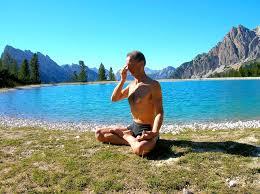Will yoga exercises help COPD patients manage breathlessness better?

Many people who suffer from a lung disease find it very hard to exercise. Often even the thought of physical activity makes them feel breathless. But there is a way to overcome these fears that only lead to a downward spiral of both physical and mental decline, practising yoga. This low impact form of exercise will not only help raising your energy levels, it also clears your mind from worry. Being good for everybody, it is also more and more recommended especially for people with lung diseases, like emphysema, chronic bronchitis, and other lung diseases commonly known as COPD.
Why can yoga exercises be especially beneficial for COPD patients?
In yoga practice there are two essential parts that complement each other in a synergistic way. One part is the Asanas, physical posture that improve range of motion, balance, flexibility and strength of the body. The other part is the Pranayamas, breathing techniques that teach you how to control your breathing and keep your lungs more fully. It also strengthens your respiratory muscles. The two combined will help you improve your general fitness and make breathing easier and more efficient. Additional meditation helps relieve stress and anxiety, which allows you to extend the benefits of the pranayamas and asanas.
Pranayamas, breathing techniques, that can be beneficial for COPD patients are:
Pursed-lip Breathing
This is an exercise especially suitable to learn control your breathlessness. While leaning slightly forward you slowly breath out with your lips pursed, imagine you are blowing a kiss or cooling your soup. This slows down the exhalation and stimulates the abdominal muscles to contract and forces the diaphragm upwards, so the lungs will empty themselves better. Instead of long inhalations and short exhalations, which is a common reaction to breathlessness, you learn to do it the other way around, with an ideal rhythm being to make the exhalation twice as long as the inhalation. Not only will this calm you down and relieve the breathlessness, it also help to strengthen the breathing muscles.
Abdominal or Belly Breathing
COPD patient can benefit especially from the abdominal breathing technique, as it stimulates the diaphragm moving upward and downward, so more oxygen can be taken into the lower lobes of the lungs and spread through the body. At the same time the abdominal organs are massaged by the moving diaphragm, thus improving their intake of oxygen and functioning. By doing the belly breath your body relaxes and becomes re-energized at the same time.
Ujjayi Breathing or Ocean Breath
This is a special form of breath, typically used while practicing asanas. It is used to slow down the breath and make an audible sound by creating a constriction in the base of your throat, like you do when blowing out to create a fog on a mirror. It helps you to stay calm during the practice while focusing on the sound and avoiding breathlessness. It also is said to create heat in your body, which helps to keep up your energy levels throughout the practice. The diaphragm controls the length and the speed of your breath and will become stronger in doing so.
Correct breathing is an essential part of yoga; as the blood will be provided with more oxygen, which makes it possible to control energy levels and this will help you relax and calm your mind. Once you have controlled your breath by practicing pranayamas, you will feel more comfortable and confident to start practicing asanas.
Asanas, physical postures, recommended for COPD patients are:
Standing Mountain Pose
This is a straightforward pose, from which all other standing poses are performed. It requires you to stand tall, either with your arms raised or left hanging loosely at your sides. It teaches you to align your spine and balance the weight of your body, while focusing on your inner self. Your chest will open up and breathing will become easier.
Standing Back Bend
This pose is performed from the Standing Mountain Pose by placing your hands on your lower back with the fingers pointing down and arching your spine back. It helps to release tension in your neck and shoulders and opens up the respiratory system.
Standing Side Bends
These bends not only improve your posture by standing taller, it also regulates your breathing. The basic standing side bend is easily performed from the Standing Mountain pose. By exhaling with each bend, you stretch alternately to the left and to the right. This calming pose improves the flexibility of your rib cage and helps to strengthen your diaphragm to make breathing easier.
Seated Forward Bends
There are several seated forward bends, performed from either a chair or the floor. These poses calm the brain, stimulate the organs and stretch the spine and the shoulders to give more room to your lungs and help you to relax.
These are only a few examples of pranayamas and asanas that you can practice to help improve your lung condition. If reading this story triggered your enthusiasm to give it a try, do take some precautions before you begin. Things to consider are for example:
– Consult with your doctor or respiratory therapist about what is possible in your condition
– Always join a recognized yoga school, don´t go practicing by yourself without any coaching
– Be sure the yoga teacher of your choice is qualified, also for training special groups like COPD patients
– During class, always keep your inhaler or oxygen supply at hand
– Don´t overexert yourself, take a rest if you get exhausted or experience shortness of breath
With these precautions in mind and a good yoga teacher, you will surely be able to experience the benefits that can yoga give you, a fitter body and a mind more at ease.
Websites consulted:
http://www.healthline.com/health/copd/yoga#1
http://yogachicago.com/2014/03/yoga-for-chronic-obstructive-pulmonary-disease-copd/
https://www.doyogawithme.com/yoga_breathing




